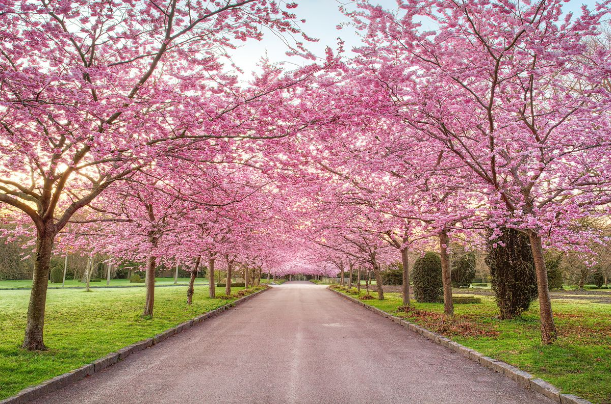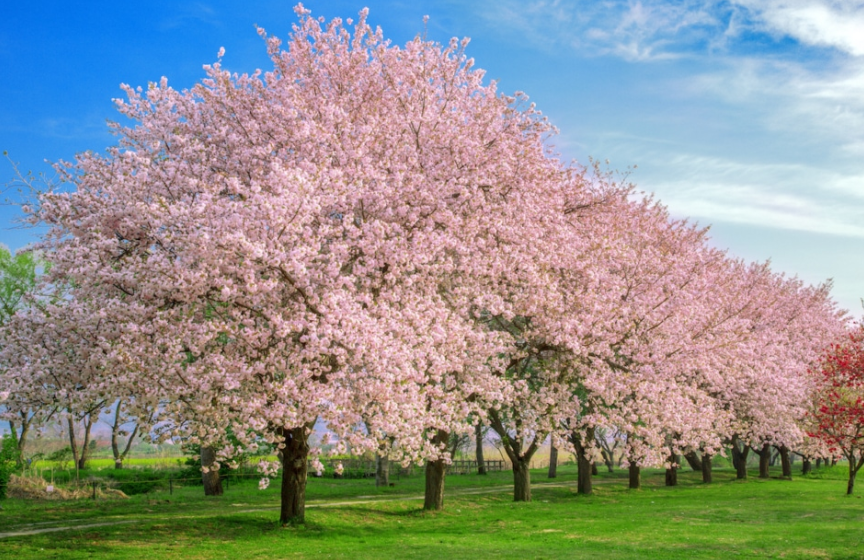
Cherry Blossom Trees, also known as Sakura Trees, are a type of ornamental cherry trees native to Japan, Korea, and China. The delicate pink or white flowers of these trees bloom each spring, for only about a week or two. These trees are a cultural icon in Japan, steeped in history, symbolism and aesthetic appreciation.
Sakura trees are often called Japanese cherry in English. (This is also a common name for Prunus serrulata). Wild species of cherry tree are widely distributed, mainly in the Northern Hemisphere. They are common in East Asia, especially in Japan, where they have been cultivated, producing many varieties.
The Japanese term “sakura” can refer to either the tree itself or its flowers. Cherry blossoms are considered the national flower of Japan, and are central to the custom of hanami, which is the tradition of picnicking under a blooming cherry blossom tree. This tradition goes back many centuries and is a time of festivals and celebrations in honor of the cherry blossoms.
The appreciation of cherry blossoms in Japan dates back centuries. Legends say Emperor Keitai planted a sakura tree 1,500 years ago to mark his rise to the throne. In the early 20th century, the practice of gifting sakura trees as tokens of friendship spread and with time the tree became deeply intertwined with Japanese culture.
Today in Japan, the blooming of cherry blossoms symbolizes the beauty and transience of life, a concept known as “mono no aware”. This tradition dates back to the Heian period (794-1185) when aristocrats would gather under cherry trees to enjoy the beauty of the flowers.
The cultivation of ornamental cherry trees began to spread in Europe and the United States in the early 20th century, particularly after Japan presented trees to the United States as a token of friendship in 1912. British plant collector Collingwood Ingram conducted important studies of Japanese cherry trees after the First World War.
Cherry blossom trees are not to be confused with cherry trees that produce fruit. While both types of trees have blossoms, ornamental cherry trees are bred specifically for their flowers, and do not produce edible cherries. There are many different varieties of cherry blossom trees, with flowers that range in color from white to deep pink.
Most sakura trees are small to medium-sized, with a lifespan of 15-30 years, though some can live longer. Their bark is smooth and reddish-brown, and their green leaves turn vibrant shades of yellow, red, or crimson in autumn. While subtle, sakura blossoms have a pleasant fragrance with hints of lilac, rose, magnolia, and even almond.
Cherry blossom trees prefer full sun to partial shade and well-draining, loamy soil. They are hardy in USDA zones 5 through 8 and can grow up to 20 feet tall and 25 feet wide. They are relatively low-maintenance trees, but they do require regular watering during dry periods and may be susceptible to pests and diseases.
History of Cherry Blossom Trees In United States

In the United States, the first cherry trees were planted in Washington, D.C., in 1912 as a gift from Japan to the United States. The gift was initiated by a private citizen named David Fairchild, who was so impressed by the beauty of the cherry trees in Japan that he wanted to introduce them to the United States. The first two trees were planted by First Lady Helen Taft and Viscountess Chinda, the wife of the Japanese Ambassador, on the bank of the Tidal Basin. This event marked the beginning of the National Cherry Blossom Festival, which is celebrated annually in Washington, D.C., to commemorate the gift and the enduring friendship between Japan and the United States.
Over the years, the cherry trees in Washington, D.C., have become a symbol of spring and a popular tourist attraction. The trees have been replanted several times due to various reasons, including disease and damage. Today, there are approximately 3,800 cherry trees in Washington, D.C., and the National Cherry Blossom Festival attracts more than 1.5 million visitors each year.
The cherry blossom trees in Washington, D.C., are a mix of different varieties, including Yoshino, Kwanzan, and Akebono. The Yoshino cherry tree, which is the most common variety, is known for its delicate, white to pale pink flowers. The Kwanzan cherry tree, on the other hand, has large, deep pink flowers. The Akebono cherry tree, also known as the “daybreak” cherry, has large, pink flowers.
The cherry blossom trees in Washington, D.C., are a living symbol of the friendship between Japan and the United States.
Popular Varieties of Cherry Blossom Trees
Classifying cherry trees is often confusing, since they are relatively prone to mutation and have diverse flowers and characteristics, and many varieties (a sub-classification of species), hybrids between species, and cultivars exist. Researchers have assigned different scientific names to the same type of cherry tree throughout different periods.
In Europe and North America, ornamental cherry trees are classified under the subgenus Cerasus (“true cherries”), within the genus Prunus. Cerasus consists of about 100 species of cherry tree, but does not include bush cherries, bird cherries, or cherry laurels (other non-Cerasus species in Prunus are plums, peaches, apricots, and almonds). In China and Russia, where there are many more wild cherry species than in Europe, Cerasus continues to be used as a genus.
Some of the most popular varieties include:
- Yoshino Cherry (Prunus x yedoensis): Usually has a cloud of pale pink blossoms that steal the show in early spring.
- Kwanzan Cherry (Prunus serrulata ‘Kanzan’): A late-blooming variety with large, double pink flowers.
- Okame Cherry (Prunus ‘Okame’): An early-blooming variety with deep pink flowers.
- Sargent’s Cherry (Prunus sargentii): Usually has masses of light-pink flowers.
- Fuji Cherry (Prunus incisa): Usually has dainty white single flowers.
- Higan Cherry (Prunus subhirtella): A species with pink flowers.
- Akebono Cherry (Prunus x yedoensis ‘Akebono’): A popular variety with large, pink flowers that bloom in early spring.
- Yamazakura (Wild Mountain Cherry): It has single pink blossoms with five petals and reddish-brown branches.
- Shidarezakura (Weeping Cherry): This weeping cherry tree has cascading branches adorned with delicate pink or white flowers.
- Ukon (Yellow Flowered Cherry): Usually has pale yellow, single flowers with five petals. It’s a rare and beautiful sight.
- Fugenzo (Double Weeping Cherry): This weeping cherry has double pink flowers that cascade down its branches.
- Ichiyou (One-Petal Cherry): As the name suggests, this unusual variety has single flowers with just one large petal.
Many cherry species and cultivars bloom between March and April in the Northern Hemisphere. Wild cherry trees, even if they are the same species, differ genetically from one individual to another. Even if they are planted in the same area, there is some variation in the time when they reach full bloom. In contrast, cultivars are clones propagated by grafting or cutting, so each tree of the same cultivar planted in the same area will come into full bloom all at once due to their genetic similarity